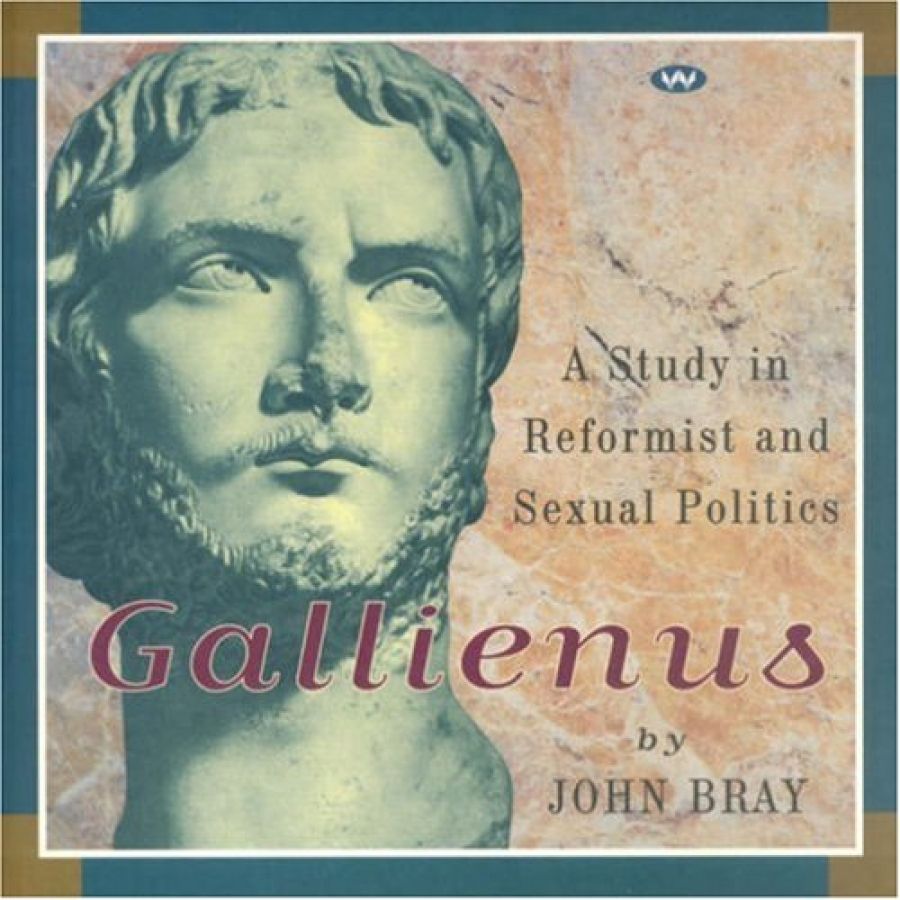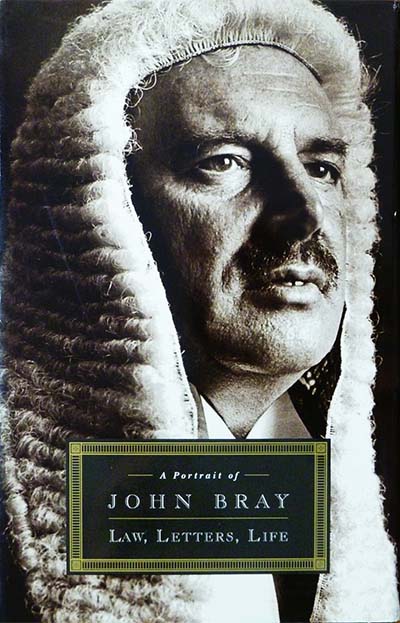
- Free Article: No
- Contents Category: Biography
- Review Article: Yes
- Article Title: From Ancient Rome to Adelaide
- Online Only: No
- Custom Highlight Text:
Gallienus is hardly the best known Roman Emperor. The records of his reign from 235 to 268 are so fragmentary that even the date of his assassination can only be approximated as taking place during a six-month period.
- Book 1 Title: Gallienus
- Book 1 Subtitle: A study in reformist and sexual politics
- Book 1 Biblio: Wakefield Press $34.95pb, 404pp
- Book 2 Title: A Portrait of John Bray
- Book 2 Subtitle: Law, letters, life
- Book 2 Biblio: Wakefield Press $32.00pb, $55.00 hb, 191pp
- Book 2 Cover Small (400 x 600):

Most historians have relied on an extremely limited range of traditional sources in summing up the Emperor’s reign. Many have simply followed Edward Gibbon in his Decline and Fall of the Roman Empire. Gibbon described Gallienus as a ‘contemptible prince’, well-versed in poetry, gardening, and cooking but destitute of judgment in war and government.
For John Bray, the sixth Chief Justice of South Australia, however, this became a remarkable scholarly challenge. It was a pilgrimage that lasted for almost forty years as he explored every nuance of language in the ancient writings on Gallienus and searched for other sources to produce the first major biography on the Emperor whose murder was a turning point in Roman history.
Even in the twelve months before his death at eighty-two, in 1995, the former Chief Justice was still reinforcing and refining his arguments that Gallienus had been unfairly maligned by Gibbon and many others. Finally, his biography of the Emperor has now appeared posthumously, released by his literary executors through the Wakefield Press. In itself, the book is an eloquent testimony to its author and the effort he put into writing it; finely, even luxuriously designed, with elegant printing and presentation, together with carefully chosen illustrations that effectively illuminate the text. But it is also much more than that.
Bray argues a good case that Gallienus was far more subtle in his dealings with the Roman Senate and the Roman army than Gibbon and his disciples have ever conceded. He shows convincingly that the Emperor’s greatest political failure, which led to his murder, was to alienate both the Roman senatorial class and the leaders of the Roman Army at the same time, albeit for different reasons.
But even without this, he provides a wealth of fascinating detail that stands in its own right as a significant contribution to understanding Roman life at the time.
The Emperor’s enemies charged him with being indolent and indulging in outrageous luxury. He was decried for being too heavily influenced by his wife and other women. As much as anything, he was vilified for his private lifestyle. He was attacked for associating with pimps, actors, and buffoons in taverns and brothels and engaging in wild sexual pleasures. There were allegations of transvestism and effeminacy.
As John Bray deals with these and other claims against the Emperor he opens up vistas on many of the lesser known features of Roman life at the time. He provides glimpses of its theatrical scene, the state of its poetry, the situation of the Roman Empire’s various religions, including the highly secret cult of Eleusis that Gallienus subscribed to on a visit to Greece.
Beyond that, however, the former Chief Justice also clearly had another mission in writing about Gallienus. Openly at times, on other occasions almost subliminally, he uses the tribulations of the Emperor as parables that can be related to more recent times, not least in Australia in the past fifty years.
As he suggests, radical social change may offend a traditional ruling class, but it need not be fatal if an alternative power base is available. On the other hand, like Gallienus, if this is accompanied by offence ‘to the conservative aristocrat, the conventional philistine, the honour-seeking careerist, and the humourless technocrat’ the moves for change are likely to be short-lived. It is not hard to divine that Bray sees metaphors in this relating to the fate of reformist governments in Australia, including the defeat of the Whitlam government in 1975. Similarly, he warns that political flamboyance accompanied by an extravagant lifestyle, exhibitionism, or ‘camping it up’ can also have fateful consequences in curtailing worthwhile government activities.
Whether fully intentionally or not, however, like most biographers, the former Chief Justice also reveals parts of himself in his writing. Personally, he mostly expected to be surrounded by the same individual rights to privacy he defended for others in his years on the bench and elsewhere. But this is not always so in his Gallienus.
Former South Australian Premier Don Dunstan noted in his memoirs that Bray’s main associates were ‘authors, artists and actors’. A former judicial colleague recorded there was opposition to his appointment as Chief Justice as some felt ‘judicial dignity was inconsistent with meeting one’s friends in the front bar of a hotel or wearing casual clothes in the street’.
This background makes it hardly surprising that the former Chief Justice is more understanding of the Emperor’s literary and theatrical interests than many of his critics. It helps to explain his considerable indulgence towards the Emperor’s nocturnal roistering in taverns and elsewhere. But far more illuminating in terms of Bray himself, he expresses opinions with contemporary significance in summing up some of the Emperor’s activities. This provides windows into his own mind that are not readily to be discovered elsewhere.
The former Chief Justice’s deep belief in the sanctity of individual privacy is summed up in his consideration of Gallienus’ seemingly ambivalent approach to religion. As Bray justifies it, there can be no objection to a person keeping the ‘secrets of the spirit’ enclosed inviolate within their own mind. He also affirms that, like Gallienus, seeking after pleasures in various forms is not inconsistent with the attainment of high levels of achievement. There is, he attests, no contradiction between ‘an addiction to carnal pleasure and literary, artistic and intellectual activities’. Similarly, he asserts that vulgarity in the pursuit of pleasure is not incompatible with highly civilised behaviour.
In contrast, with some exceptions, the nine essays in A Portrait of John Bray are mostly considerably less revealing about him personally. Quite rightly, as Professor Wilfred Prest assumes in his Preface, they are not to be regarded as a substitute for a biography of the former Chief Justice. Together, however, they highlight a multi-faceted life that singled John Bray out as one of the most notable representatives of his generation, but most especially so in South Australia.
After a visit to Europe just before World War II, he did not go overseas for another thirty-six years. His professional and other interests were almost entirely centred on Adelaide. He became a focal point in a ‘new’ establishment that largely displaced a local, self-proclaimed aristocracy and other groupings that had dominated State affairs for most of the twentieth century.
Much of the flavour of this, Bray’s associations with some of those deeply involved with the political and social revolution that took place in South Australia in the 1960s and 1970s, is discussed in the opening essay in the Bray Portrait by his long-time friend Peter Ward.
Professionally, Bray demonstrated that the long established division between barristers and solicitors in three Australian States was no guarantee of the qualities required in the conduct of litigation that has been claimed for it. By the time of his elevation to the Supreme Court he was the acknowledged leader of the local bar while still remaining a member of an ordinary legal firm.
He shone in complex civil litigation. But he was also an outstanding criminal advocate, as Michael Abbott, a present day leader of the South Australia bar, relates in one of the best and most revealing contributions to the Bray Portrait. As he shows, the future Chief Justice began his career at the bar with the reputation of being ‘a learned but not particularly worldly person’. But he made a conscious decision to represent those whose rights might be infringed and ‘ended up with a reputation for being a champion of the underdog’.
On the bench, he blended conservatism in his dealings with many traditional areas of law with a liberalism that often reflected the same values he espouses in his Gallienus. Andrew Ligertwood of the University of Adelaide Law School sums up this liberalism very well in his essay. As he affirms, ‘he was tolerant of the unusual, protective of the individual from oppression by the state’. In addition, he was ‘committed to the rights of individuals to hold opinions and act within their realms of morality free from the threat of interference by the state’.
It was this as much as anything that helped to make the ‘Bray Court’ influential well beyond the boundaries of South Australia. But this was also enhanced in other ways, as Michael Kirby of the High Court records in another essay, as Bray headed the most talented array of Supreme Court judges in the history of the State.
All this, however, was only one aspect of his ‘large minded cultivation’, as Wilfred Prest describes it. Gallienus was one product of Bray’s almost lifelong fascination with classical studies. The naming of the research collection of the State Library after him – a voracious, omnivorous reader – duly recognised his heartfelt battles, on the State Libraries Board, to maintain the collection, as Jean Whyte records in an essay in the Bray Portrait. Dame Roma Mitchell’s contribution to this collection is outstanding. She was a near contemporary of Bray’s, served with him on the Supreme Court bench and followed him as Chancellor of the University of Adelaide. She writes feelingly of his thwarted ambition to become a University academic, despite obtaining one of the few doctorates in law awarded in Australia before the Second World War. Nevertheless, as she shows, he remained actively and purposively associated with the University of Adelaide for the remainder of his life.
Bray was also never far away from the vibrant and often turbulent world of Adelaide’s cultural renaissance in the 1960s and 1970s, even after he joined the Supreme Court. He had already staked out his credentials with a verse play performed in 1955, followed by his first book of verse in 1962. He took his place on the platform at annual Writers’ Weeks in Adelaide, reading his latest works. He took obvious and justified pleasure in being recognised as a ‘writer’ in the company of prominent literary figures from Australia and overseas.
Much of this writing was based on classical themes. But as Brian Medlin, one of his oldest friends and literary associates, neatly remarks in the Bray Portrait, he was also ‘extraordinarily a poet of the ordinary’. As he goes on: ‘Lost teeth, brands of fags, ants in the kitchen, you name it ... were all material for Bray’.
Again like his Gallienus, however, there were deeper implications in mind, so the poet Andrew Taylor suggests in a complementary essay. He sees Bray portraying favourably a ‘lack of sexual guilt, an enjoyment of all the appetites and an outspoken honesty bordering on the brutal’.
Nevertheless, with all this, much remains unsaid about the character of South Australia’s sixth Chief Justice and his place in the rapid evolutionary changes that took place in South Australia in which he played a central role.
There is also much still to be revealed of the way his appointment as Chief Justice of South Australia was an integral part of the political and social revolutions that helped to move the State away from the conservative political and social hegemonies that previously had dominated most of its European-based history.


Comments powered by CComment